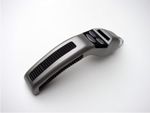Personal phaser: Difference between revisions
No edit summary |
No edit summary |
||
| Line 7: | Line 7: | ||
* '''Type 2 Phaser,''' the standard armament for away teams. | * '''Type 2 Phaser,''' the standard armament for away teams. | ||
More powerful [[Phaser Rifle|phaser rifle]]s and other weapons are also available for special circumstances and missions when heavy hostile retaliation is expected. | More powerful '''[[Phaser Rifle|phaser rifle]]s''' and other weapons are also available for special circumstances and missions when heavy hostile retaliation is expected. | ||
==Current Models== | ==Current Models== | ||
<gallery> | <gallery widths="150px" heights="150px"> | ||
File:Type 1 phaser.jpg|Type 1 Phaser | File:Type 1 phaser.jpg|Type 1 Phaser | ||
File:Type 2 phaser-front.jpg|Type 2 Phaser | File:Type 2 phaser-front.jpg|Type 2 Phaser | ||
Revision as of 06:02, 27 January 2014
| Starfleet Equipment & Devices |
|---|
| • COMMUNICATOR | • TRICORDER | • PADD |
| • MEDKIT | • PERSONAL PHASERS | • PHASER RIFLES & HEAVY WEAPONRY |
|
The personal phaser is the primary sidearm of Starfleet personnel. TypesTwo types of personal phasers are currently in use:
More powerful phaser rifles and other weapons are also available for special circumstances and missions when heavy hostile retaliation is expected. Current ModelsBecause of their small size, type 1 phasers are informally known as "cricket" phasers by Starfleet personnel. The current type 1 phaser model was introduced in 2373. The current Type 2 phaser model was introduced in 2379. This model in particular is informally referred to by personnel as a "dolphin" phaser because of its redesigned emitter compared to earlier models. Specifications
OperationsThe phaser energy is released through the application of the Rapid Nadion Effect (RNE). Rapid nadions are short-lived subatomic particles possessing special properties related to high-speed interactions within atomic nuclei. Among these properties is the ability to liberate and transfer strong nuclear forces within a particular class of super-conducting crystals known as fushigi-no-umi. The crystals were so named when it appeared to researchers at Starfleet's Tokyo R&D facility that the materials being developed represented a virtual "sea of wonder" before them. |



